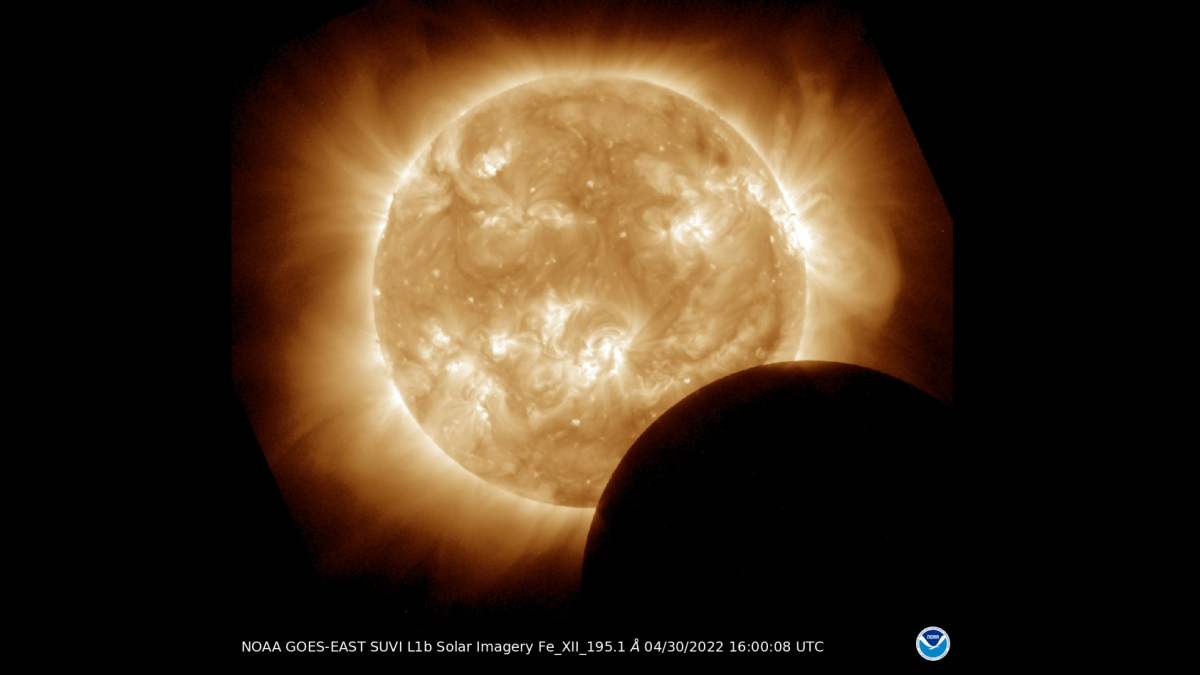The 1st solar eclipse of 2022 is stunning in these satellite views
We also got a glimpse from a solar telescope in Chile.

Professional observatories in Earth and space caught a spectacular eclipse of the sun in between their usual duties checking out solar weather.
The partial solar eclipse of April 30 was visible in a narrow band across parts of Antarctica, the southern tip of South America and the Pacific and Atlantic Oceans, and apparently, also in space.
The National Oceanic and Atmospheric Administration shared views on Twitter from two GOES series satellites that saw the moon passing in front of the face of the sun, from Earth's perspective.
Related: Black Moon solar eclipse looks otherworldly in stunning images
"The Solar Ultraviolet Imager (#SUVI) on #GOES16 caught a glimpse of the moon's disk as it passed in front of the Sun during the first #solareclipse of 2022," NOAA tweeted, along with a picture of the GOES-16 footage.
GOES-East also caught a quick view of the moon's shadow moving towards Chile, before it got lost in the sunset, per a second NOAA tweet.
#SATELLITE SPOTLIGHT: On April 30, the Solar Ultraviolet Imager (#SUVI) on @NOAA's #GOES16🛰️caught a glimpse of the Moon's disk as it passed in front of the Sun during the first #SolarEclipse of 2022. This partial solar #eclipse was only visible across the Southern Hemisphere. pic.twitter.com/o1D5YGvQ7YMay 3, 2022
Despite the fact that this was a partial eclipse, the #GOESEast satellite caught a brief glimpse of the moon's shadow approaching Chile from the west before it merged with the sunset. Can you see it? https://t.co/SzgykpThNI pic.twitter.com/rb2x5BCfJnMay 3, 2022
From Chile, a National Science Foundation telescope at Cerro Tololo that's part of the Global Oscillation Network Group (GONG) project also captured part of the partial solar eclipse, which was the first of 2022.
Get the Space.com Newsletter
Breaking space news, the latest updates on rocket launches, skywatching events and more!
If you missed this eclipse, the next eclipse will be a total lunar eclipse that begins on May 15; the next solar eclipse will occur on Oct. 25.
Don't blink, or you might miss it! The @NSF GONG telescope at @NOIRLabAstroES Cerro Tololo site (Chile) captured a glimpse of a partial #solareclipse over the weekend, visible in the Southern Hemisphere. This marks the first solar eclipse of 2022! #NSFfunded @cerrotololo pic.twitter.com/XSMkukxQljMay 2, 2022
You can prepare for the next solar eclipse with our guide on how to photograph a solar eclipse safely. Our guides on the best cameras for astrophotography and the best lenses for astrophotography can help you find the camera gear you need to capture your own snapshots.
Follow Elizabeth Howell on Twitter @howellspace. Follow us on Twitter @Spacedotcom and on Facebook.
Join our Space Forums to keep talking space on the latest missions, night sky and more! And if you have a news tip, correction or comment, let us know at: community@space.com.

Elizabeth Howell (she/her), Ph.D., was a staff writer in the spaceflight channel between 2022 and 2024 specializing in Canadian space news. She was contributing writer for Space.com for 10 years from 2012 to 2024. Elizabeth's reporting includes multiple exclusives with the White House, leading world coverage about a lost-and-found space tomato on the International Space Station, witnessing five human spaceflight launches on two continents, flying parabolic, working inside a spacesuit, and participating in a simulated Mars mission. Her latest book, "Why Am I Taller?" (ECW Press, 2022) is co-written with astronaut Dave Williams.
